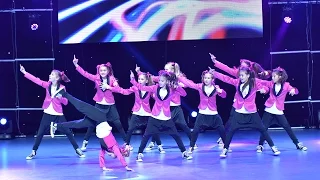Hip-Hop dance is the dance which amaze me....
History
Hip-hop dance refers to street dance styles primarily performed to hip-hop music or that have evolved as part of hip-hop culture. It includes a wide range of styles primarily breaking, locking, and popping which were created in the 1970s and made popular by dance crews in the United States. The television show Soul Train and the 1980s films Breakin', Beat Street, and Wild Style showcased these crews and dance styles in their early stages; therefore, giving hip-hop mainstream exposure. The dance industry responded with a commercial, studio-based version of hip-hop—sometimes called "new style". Classically trained dancers developed these studio styles in order to create choreography from the hip-hop dances that were performed on the street. Because of this development, hip-hop dance is practiced in both dance studios and outdoor spaces.
Though the dance is established in entertainment, including mild representation in theater, it maintains a strong presence in urban neighborhoods which has led to the creation of street dance derivatives Memphis jookin, turfing, jerkin', and krumping.
1980s films, television shows, and the Internet have contributed to introducing hip-hop dance outside of the United States. Since being exposed, educational opportunities and dance competitions have helped maintain its presence worldwide.
What distinguishes hip-hop from other forms of dance is that it is often "freestyle" (improvisational) in nature and hip-hop dance crews often engage in freestyle dance competitions—colloquially referred to as "battles". Crews, freestyling, and battles are identifiers of this style. Hip-hop dance can be a form of entertainment or a hobby. It can also be a way to stay active in competitive dance and a way to make a living by dancing professionally.
Main styles
Breaking
Breaking was created in the South Bronx, New York City during the early 1970s. It is the first hip-hop dance style. At the time of its creation, it was the only hip-hop dance style because Afrika Bambaataa classified it as one of the five pillars of hip-hop culture along with MCing (rapping), DJing (turntablism), graffiti writing, and knowledge. Breaking includes four foundational dances: toprock, footwork-oriented steps performed while standing up; downrock, footwork performed with both hands and feet on the floor; freezes, stylish poses done on your hands; and power moves, complex and impressive acrobatic moves. Transitions from toprock to downrock are called "drops."
Locking
Locking, originally called Campbellocking, was created in 1969 in Los Angeles, California by Don "Campbellock" Campbell and popularized by his crew The Lockers.
Locking looks similar to popping, and the two are frequently confused by the casual observer. In locking, dancers hold their positions longer. The lock is the primary move used in locking. It is "similar to a freeze or a sudden pause." A locker's dancing is characterized by frequently locking in place and after a brief freeze moving again. According to Dance Spirit magazine, a dancer cannot perform both locking and popping simultaneously; thus, it is incorrect to call locking "pop-locking".
Popping
Popping was created in Fresno, California in the 1970s and popularized by Samuel "Boogaloo Sam" Solomon and his crew the Electric Boogaloos. It is based on the technique of quickly contracting and relaxing muscles to cause a jerk in a dancer's body, referred to as a pop or a hit. Each hit should be synchronized to the rhythm and beats of the music. Popping is also used as an umbrella term to refer to a wide range of closely related illusionary dance styles such as strobing, liquid, animation, twisto-flex, and waving.Dancers often integrate these styles with standard popping to create a more varied performance. Popping as an umbrella term also includes floating, gliding, and sliding.
Pictures

Video

https://www.youtube.com/watch?v=bQHs77sHg3M













